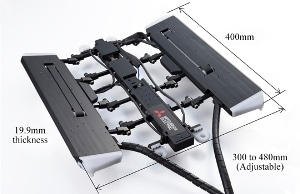Jan 25 2017
 Ultra-thin inspection robot. Credit: Mitsubishi Electric Corporation
Ultra-thin inspection robot. Credit: Mitsubishi Electric Corporation
Mitsubishi Electric Corporation has announced the development of a 19.9-mm-thin inspection robot that can perform power generator inspection by passing through the narrow gap between the stator and rotor, eliminating the requirement to remove the rotor. This robot reduces time and cost of inspections and helps increase the availability and reliability of power generators.
Traditional generators inspections are performed by professionals every four years and they require about 34 days to complete, partly because the rotor have to be removed. Electric power companies have been seeking to reduce these inspections and improve inspection accuracy to increase the availability of their generators.
The ultra-thin inspection robot from Mitsubishi Electric eliminates the requirement to remove the rotor, so that inspections can be finished in just six days. Due to its high accuracy, inspections can be performed less frequently than every four years and assist operators to avoid stocking parts they do not actually require. Therefore, Mitsubishi Electric's new robot is projected to help reduce total costs of inspection and improve both the availability and reliability of power generators.
Features
Traditional inspection robots are about 30-mm thick, so they will not be able to pass through the narrow gap between the stator and rotor in about 30% of Mitsubishi Electric power generators. The new ultra-thin inspection robot from Mitsubishi Electric is designed to pass through the narrow gap between the generator's stator and rotor to carry out accurate inspections, including detailed visual examinations, assessment of stator wedge tightness, and core insulation inspections.
The robot includes a proprietary traveling mechanism consisting of flat plate and crawler belt to achieve low vibration and a thin 19.9-mm profile for accurate data acquisition. It can able to inspect Mitsubishi Electric’s all mid- and large-sized generators.
The robot's proprietary tapping mechanism incorporates a space-saving cam. It is capable of providing a striking force that is 10 times that of a traditional mechanism. The tapping test employs original vibration analysis technology in order to precisely detect five levels of stator wedge tightness compared to the three levels detectable by a traditional robot.